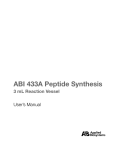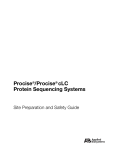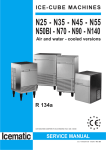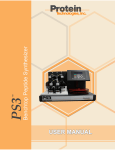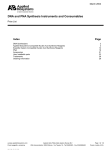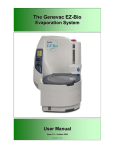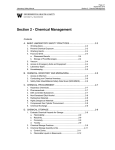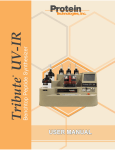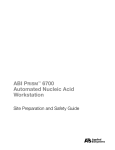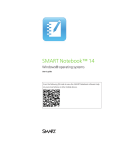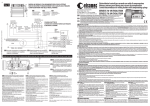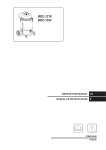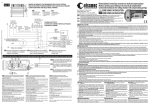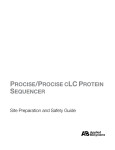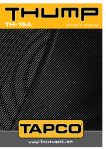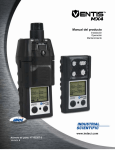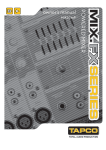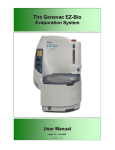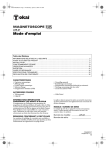Download GeneAmp® 5700 Sequence Detection System
Transcript
GeneAmp® 5700 Sequence Detection System Site Preparation and Safety Guide © Copyright 2000, Applied Biosystems For Research Use Only. Not for use in diagnostic procedures. ABI PRISM and GeneAmp are registered trademarks of Applera Corporation or its subsidiaries in the U.S. and certain other countries. All other trademarks are the sole property of their respective owners. Contents 1 Site Preparation Before You Start.... . . . . . . . . . . . . . . . . . . . . . . . . . . . . . . . . . . . . . . . . . . . . . . . . . . . . . . . . . . . 1-1 Pre-installation. . . . . . . . . . . . . . . . . . . . . . . . . . . . . . . . . . . . . . . . . . . . . . . . . . . . . . . . . 1-1 Operator Training. . . . . . . . . . . . . . . . . . . . . . . . . . . . . . . . . . . . . . . . . . . . . . . . . . . . . . . 1-1 Performance Verification . . . . . . . . . . . . . . . . . . . . . . . . . . . . . . . . . . . . . . . . . . . . . . . . . 1-1 Ordering Supplies . . . . . . . . . . . . . . . . . . . . . . . . . . . . . . . . . . . . . . . . . . . . . . . . . . . . . . 1-1 Unpacking . . . . . . . . . . . . . . . . . . . . . . . . . . . . . . . . . . . . . . . . . . . . . . . . . . . . . . . . . . . . 1-1 Technical Support . . . . . . . . . . . . . . . . . . . . . . . . . . . . . . . . . . . . . . . . . . . . . . . . . . . . . . . . . . . . 1-2 Contacting Technical Support . . . . . . . . . . . . . . . . . . . . . . . . . . . . . . . . . . . . . . . . . . . . . 1-2 To Contact Technical Support by E-Mail . . . . . . . . . . . . . . . . . . . . . . . . . . . . . . . . . . . . 1-2 Hours for Telephone Technical Support . . . . . . . . . . . . . . . . . . . . . . . . . . . . . . . . . . . . . 1-2 To Contact Technical Support by Telephone or Fax . . . . . . . . . . . . . . . . . . . . . . . . . . . . 1-2 To Reach Technical Support Through the Internet . . . . . . . . . . . . . . . . . . . . . . . . . . . . . 1-5 To Obtain Documents on Demand. . . . . . . . . . . . . . . . . . . . . . . . . . . . . . . . . . . . . . . . . . 1-5 Preinstallation Checklist. . . . . . . . . . . . . . . . . . . . . . . . . . . . . . . . . . . . . . . . . . . . . . . . . . . . . . . 1-6 About this Checklist . . . . . . . . . . . . . . . . . . . . . . . . . . . . . . . . . . . . . . . . . . . . . . . . . . . . 1-6 Checklist . . . . . . . . . . . . . . . . . . . . . . . . . . . . . . . . . . . . . . . . . . . . . . . . . . . . . . . . . . . . . 1-6 Items Shipped with This Instrument. . . . . . . . . . . . . . . . . . . . . . . . . . . . . . . . . . . . . . . . . . . . . . 1-7 Summary . . . . . . . . . . . . . . . . . . . . . . . . . . . . . . . . . . . . . . . . . . . . . . . . . . . . . . . . . . . . . 1-7 Hazardous Chemicals Warning . . . . . . . . . . . . . . . . . . . . . . . . . . . . . . . . . . . . . . . . . . . . 1-7 Installation Chemical Kit. . . . . . . . . . . . . . . . . . . . . . . . . . . . . . . . . . . . . . . . . . . . . . . . . 1-7 Items Needed but Not Supplied . . . . . . . . . . . . . . . . . . . . . . . . . . . . . . . . . . . . . . . . . . . . . . . . . 1-8 Resupply . . . . . . . . . . . . . . . . . . . . . . . . . . . . . . . . . . . . . . . . . . . . . . . . . . . . . . . . . . . . . 1-8 Water . . . . . . . . . . . . . . . . . . . . . . . . . . . . . . . . . . . . . . . . . . . . . . . . . . . . . . . . . . . . . . . . 1-8 Equipment and Supplies . . . . . . . . . . . . . . . . . . . . . . . . . . . . . . . . . . . . . . . . . . . . . . . . . 1-8 Laboratory Safety . . . . . . . . . . . . . . . . . . . . . . . . . . . . . . . . . . . . . . . . . . . . . . . . . . . . . . . . . . . . 1-9 Onsite Representative . . . . . . . . . . . . . . . . . . . . . . . . . . . . . . . . . . . . . . . . . . . . . . . . . . . 1-9 Required Safety Equipment. . . . . . . . . . . . . . . . . . . . . . . . . . . . . . . . . . . . . . . . . . . . . . . 1-9 Laboratory Space Required . . . . . . . . . . . . . . . . . . . . . . . . . . . . . . . . . . . . . . . . . . . . . . . . . . . 1-10 Dimensions and Weight . . . . . . . . . . . . . . . . . . . . . . . . . . . . . . . . . . . . . . . . . . . . . . . . . 1-10 Location of Instrument . . . . . . . . . . . . . . . . . . . . . . . . . . . . . . . . . . . . . . . . . . . . . . . . . 1-10 Clearance . . . . . . . . . . . . . . . . . . . . . . . . . . . . . . . . . . . . . . . . . . . . . . . . . . . . . . . . . . . . 1-10 Typical Laboratory Layout . . . . . . . . . . . . . . . . . . . . . . . . . . . . . . . . . . . . . . . . . . . . . . 1-10 Electrical Requirements . . . . . . . . . . . . . . . . . . . . . . . . . . . . . . . . . . . . . . . . . . . . . . . . . . . . . . 1-11 Power . . . . . . . . . . . . . . . . . . . . . . . . . . . . . . . . . . . . . . . . . . . . . . . . . . . . . . . . . . . . . . . 1-11 Grounding . . . . . . . . . . . . . . . . . . . . . . . . . . . . . . . . . . . . . . . . . . . . . . . . . . . . . . . . . . . 1-11 Power Cords. . . . . . . . . . . . . . . . . . . . . . . . . . . . . . . . . . . . . . . . . . . . . . . . . . . . . . . . . . 1-11 Voltage Quality . . . . . . . . . . . . . . . . . . . . . . . . . . . . . . . . . . . . . . . . . . . . . . . . . . . . . . . 1-11 iii Voltage Spikes. . . . . . . . . . . . . . . . . . . . . . . . . . . . . . . . . . . . . . . . . . . . . . . . . . . . . . . . Power Outages . . . . . . . . . . . . . . . . . . . . . . . . . . . . . . . . . . . . . . . . . . . . . . . . . . . . . . . Laboratory Environmental Requirements . . . . . . . . . . . . . . . . . . . . . . . . . . . . . . . . . . . . . . . . Altitude . . . . . . . . . . . . . . . . . . . . . . . . . . . . . . . . . . . . . . . . . . . . . . . . . . . . . . . . . . . . . Temperature and Humidity . . . . . . . . . . . . . . . . . . . . . . . . . . . . . . . . . . . . . . . . . . . . . . Pollution . . . . . . . . . . . . . . . . . . . . . . . . . . . . . . . . . . . . . . . . . . . . . . . . . . . . . . . . . . . . Heat . . . . . . . . . . . . . . . . . . . . . . . . . . . . . . . . . . . . . . . . . . . . . . . . . . . . . . . . . . . . . . . . Emission/ Immunity Statement. . . . . . . . . . . . . . . . . . . . . . . . . . . . . . . . . . . . . . . . . . . Laboratory Ventilation . . . . . . . . . . . . . . . . . . . . . . . . . . . . . . . . . . . . . . . . . . . . . . . . . . . . . . . Venting . . . . . . . . . . . . . . . . . . . . . . . . . . . . . . . . . . . . . . . . . . . . . . . . . . . . . . . . . . . . . 1-11 1-12 1-13 1-13 1-13 1-13 1-13 1-13 1-13 1-13 2 Instrument Safety Instrument Safety Overview . . . . . . . . . . . . . . . . . . . . . . . . . . . . . . . . . . . . . . . . . . . . . . . . . . . 2-1 Safe Operation . . . . . . . . . . . . . . . . . . . . . . . . . . . . . . . . . . . . . . . . . . . . . . . . . . . . . . . . User Attention Words . . . . . . . . . . . . . . . . . . . . . . . . . . . . . . . . . . . . . . . . . . . . . . . . . . . Instrument Labeling. . . . . . . . . . . . . . . . . . . . . . . . . . . . . . . . . . . . . . . . . . . . . . . . . . . . . . . . . . Safety Labels. . . . . . . . . . . . . . . . . . . . . . . . . . . . . . . . . . . . . . . . . . . . . . . . . . . . . . . . . . Signal Words . . . . . . . . . . . . . . . . . . . . . . . . . . . . . . . . . . . . . . . . . . . . . . . . . . . . . . . . . . Labels That May Be Found On Your Instrument . . . . . . . . . . . . . . . . . . . . . . . . . . . . . . Safety Alert Symbols . . . . . . . . . . . . . . . . . . . . . . . . . . . . . . . . . . . . . . . . . . . . . . . . . . . . . . . . . Electrical Symbols . . . . . . . . . . . . . . . . . . . . . . . . . . . . . . . . . . . . . . . . . . . . . . . . . . . . . Non-electrical Symbols. . . . . . . . . . . . . . . . . . . . . . . . . . . . . . . . . . . . . . . . . . . . . . . . . . Input/Output Connections . . . . . . . . . . . . . . . . . . . . . . . . . . . . . . . . . . . . . . . . . . . . . . . . . . . . . Locations. . . . . . . . . . . . . . . . . . . . . . . . . . . . . . . . . . . . . . . . . . . . . . . . . . . . . . . . . . . . . 2-1 2-1 2-1 2-1 2-1 2-2 2-3 2-3 2-3 2-8 2-8 3 Chemical Safety Introduction . . . . . . . . . . . . . . . . . . . . . . . . . . . . . . . . . . . . . . . . . . . . . . . . . . . . . . . . . . . . . . . . 3-1 Please read… . . . . . . . . . . . . . . . . . . . . . . . . . . . . . . . . . . . . . . . . . . . . . . . . . . . . . . . . . 3-1 Hazardous Chemicals . . . . . . . . . . . . . . . . . . . . . . . . . . . . . . . . . . . . . . . . . . . . . . . . . . . . . . . . 3-2 Overview. . . . . . . . . . . . . . . . . . . . . . . . . . . . . . . . . . . . . . . . . . . . . . . . . . . . . . . . . . . . . 3-2 Handling Hazardous Chemicals . . . . . . . . . . . . . . . . . . . . . . . . . . . . . . . . . . . . . . . . . . . 3-2 Hazardous Waste . . . . . . . . . . . . . . . . . . . . . . . . . . . . . . . . . . . . . . . . . . . . . . . . . . . . . . . . . . . . 3-3 Overview. . . . . . . . . . . . . . . . . . . . . . . . . . . . . . . . . . . . . . . . . . . . . . . . . . . . . . . . . . . . . 3-3 Material Safety Data Sheets Overview . . . . . . . . . . . . . . . . . . . . . . . . . . . . . . . . . . . . . . . . . . . 3-4 General Information . . . . . . . . . . . . . . . . . . . . . . . . . . . . . . . . . . . . . . . . . . . . . . . . . . . . 3-4 MSDS Sections . . . . . . . . . . . . . . . . . . . . . . . . . . . . . . . . . . . . . . . . . . . . . . . . . . . . . . . . 3-4 How to Get Extra Copies of MSDSs . . . . . . . . . . . . . . . . . . . . . . . . . . . . . . . . . . . . . . . 3-4 MSDSs for Applied Biosystems Chemicals . . . . . . . . . . . . . . . . . . . . . . . . . . . . . . . . . . 3-4 Acronyms and Abbreviations Used in Waste Profiles and MSDSs . . . . . . . . . . . . . . . . . . . . . . A-1 Introduction. . . . . . . . . . . . . . . . . . . . . . . . . . . . . . . . . . . . . . . . . . . . . . . . . . . . . . . . . . . A-1 Organizations, Regulations, and Scientific Terminology . . . . . . . . . . . . . . . . . . . . . . . . A-1 iv Units of Measure . . . . . . . . . . . . . . . . . . . . . . . . . . . . . . . . . . . . . . . . . . . . . . . . . . . . . . A-2 Chemicals . . . . . . . . . . . . . . . . . . . . . . . . . . . . . . . . . . . . . . . . . . . . . . . . . . . . . . . . . . . A-3 v Site Preparation 1 1 Before You Start... Pre-installation Before the instrument is installed, the installation site must be prepared so that the instrument can operate correctly and safely. Careful attention to the requirements presented here will simplify the installation procedure. . Operator Training Training of operators is one of the primary goals of installation. Persons who are to be trained to operate the instrument should set aside two uninterrupted days to work with the Applied Biosystems service representative. If this is not possible, the installation should be rescheduled. Performance Calibration of the instrument and verification of performance will be performed by an Verification Applied Biosystems service representative during the installation. Ordering Supplies Reagents shipped with this instrument will be consumed during the process of setup and verification. Be sure to order additional chemicals and other necessary supplies before installation for the ongoing operation of the instrument. Unpacking Do not unpack instruments. Inspect instrument cartons and report any damage to your Applied Biosystems service representative. For vital information and instructions about unpacking Installation Chemical Kit, see “Item Shipped with this Product” later in this chapter. Site Preparation 1-1 Technical Support Contacting Technical You can contact Applied Biosystems for technical support by telephone or fax, by Support e-mail, or through the Internet. You can order Applied Biosystems user documents, MSDSs, certificates of analysis, and other related documents 24 hours a day. In addition, you can download documents in PDF format from the Applied Biosystems Web site (please see the section “To Obtain Documents on Demand” following the telephone information below). To Contact Technical Contact technical support by e-mail for help in the following product areas: Support by E-Mail Product Area E-mail address Genetic Analysis (DNA Sequencing) [email protected] Sequence Detection Systems and PCR [email protected] Protein Sequencing, Peptide and DNA Synthesis [email protected] Biochromatography, PerSeptive DNA, PNA and Peptide Synthesis systems, CytoFluor®, FMAT™, Voyager™, and Mariner™ Mass Spectrometers [email protected] Applied Biosystems/MDS Sciex [email protected] Chemiluminescence (Tropix) [email protected] Hours for Telephone In the United States and Canada, technical support is available at the following times: Technical Support Product Hours Chemiluminescence 8:30 a.m. to 5:30 p.m. Eastern Time Framingham support 8:00 a.m. to 6:00 p.m. Eastern Time All Other Products 5:30 a.m. to 5:00 p.m. Pacific Time To Contact Technical In North America Support by To contact Applied Biosystems Technical Support, use the telephone or fax numbers Telephone or Fax given below. (To open a service call for other support needs, or in case of an emergency, dial 1-800-831-6844 and press 1.) Product or Product Area ABI PRISM® 3700 DNA Analyzer Telephone Dial... Fax Dial... 1-800-831-6844, 1-650-638-5981 then press 8 DNA Synthesis 1-800-831-6844, 1-650-638-5981 then press 21 Fluorescent DNA Sequencing 1-800-831-6844, 1-650-638-5981 then press 22 1-2 Site Preparation Fluorescent Fragment Analysis (includes GeneScan® applications) 1-800-831-6844, then press 23 1-650-638-5981 Integrated Thermal Cyclers (ABI PRISM ® 877 and Catalyst 800 instruments) 1-800-831-6844, then press 24 1-650-638-5981 Product or Product Area ABI PRISM ® 3100 Genetic Analyzer Telephone Dial... Fax Dial... 1-800-831-6844, 1-650-638-5981 then press 26 BioInformatics (includes BioLIMS™, BioMerge™, and SQL GT™ applications) 1-800-831-6844, then press 25 1-505-982-7690 Peptide Synthesis (433 and 43X Systems) 1-800-831-6844, then press 31 1-650-638-5981 Protein Sequencing (Procise Protein Sequencing Systems) 1-800-831-6844, 1-650-638-5981 then press 32 PCR and Sequence Detection 1-800-762-4001, then press 1 for PCR, 2 for the 7700 or 5700, 6 for the 6700 or dial 1-800-831-6844, then press 5 1-240-453-4613 Voyager MALDI-TOF Biospectrometry and Mariner ESI-TOF Mass Spectrometry Workstations 1-800-899-5858, then press 13 1-508-383-7855 Biochromatography (BioCAD Workstations and Poros Perfusion Chromatography Products) 1-800-899-5858, then press 14 1-508-383-7855 Expedite Nucleic acid Synthesis Systems 1-800-899-5858, then press 15 1-508-383-7855 Peptide Synthesis (Pioneer and 9050 Plus Peptide Synthesizers) 1-800-899-5858, 1-508-383-7855 then press 15 PNA Custom and Synthesis 1-800-899-5858, 1-508-383-7855 then press 15 FMAT 8100 HTS System and Cytofluor 4000 Fluorescence Plate Reader then press 16 Chemiluminescence (Tropix) 1-800-542-2369 (U.S. 1-800-899-5858, 1-508-383-7855 1-781-275-8581 only), or 1-781-271-0045 Applied Biosystems/MDS Sciex 1-800-952-4716 1-650-638-6223 Telephone Dial... Fax Dial... Outside North America Region Africa and the Middle East Africa (English Speaking) and West Asia (Fairlands, South Africa) 27 11 478 0411 27 11 478 0349 South Africa (Johannesburg) 27 11 478 0411 27 11 478 0349 Middle Eastern Countries and North Africa (Monza, Italia) 39 (0)39 8389 481 39 (0)39 8389 493 Eastern Asia, China, Oceania Australia (Scoresby, Victoria) 61 3 9730 8600 61 3 9730 8799 China (Beijing) 86 10 64106608 86 10 64106617 Site Preparation 1-3 Region Telephone Dial... Fax Dial... Hong Kong 852 2756 6928 852 2756 6968 Korea (Seoul) 82 2 593 6470/6471 82 2 593 6472 Malaysia (Petaling Jaya) 60 3 758 8268 60 3 754 9043 Singapore 65 896 2168 65 896 2147 Taiwan (Taipei Hsien) 886 2 22358 2838 886 2 2358 2839 Thailand (Bangkok) 66 2 719 6405 66 2 319 9788 Europe Austria (Wien) 43 (0)1 867 35 75 0 43 (0)1 867 35 75 11 Belgium 32 (0)2 712 5555 32 (0)2 712 5516 Czech Republic and Slovakia (Praha) 420 2 61 222 164 420 2 61 222 168 Denmark (Naerum) 45 45 58 60 00 45 45 58 60 01 Finland (Espoo) 358 (0)9 251 24 250 358 (0)9 251 24 243 France (Paris) 33 (0)1 69 59 85 85 33 (0)1 69 59 85 00 Germany (Weiterstadt) 49 (0) 6150 101 0 49 (0) 6150 101 101 Hungary (Budapest) 36 (0)1 270 8398 36 (0)1 270 8288 Italy (Milano) 39 (0)39 83891 39 (0)39 838 9492 Norway (Oslo) 47 23 12 06 05 47 23 12 05 75 Poland, Lithuania, Latvia, and Estonia (Warszawa) 48 (22) 866 40 10 48 (22) 866 40 20 Portugal (Lisboa) 351 (0)22 605 33 14 351 (0)22 605 33 15 Russia (Moskva) 7 095 935 8888 7 095 564 8787 South East Europe (Zagreb, Croatia) 385 1 34 91 927 385 1 34 91 840 Spain (Tres Cantos) 34 (0)91 806 1210 34 (0)91 806 1206 Sweden (Stockholm) 46 (0)8 619 4400 46 (0)8 619 4401 Switzerland (Rotkreuz) 41 (0)41 799 7777 41 (0)41 790 0676 The Netherlands (Nieuwerkerk a/d IJssel) 31 (0)180 331400 31 (0)180 331409 United Kingdom (Warrington, Cheshire) 44 (0)1925 825650 44 (0)1925 282502 All other countries not listed (Warrington, UK) 44 (0)1925 282481 44 (0)1925 282509 Japan Japan (Hacchobori, Chuo-Ku, Tokyo) 81 3 5566 6100 81 3 5566 6501 Latin America Del.A. Obregon, Mexico 1-4 Site Preparation 305-670-4350 305-670-4349 To Reach Technical We strongly encourage you to visit our Web site for answers to frequently asked Support Through questions and for more information about our products. You can also order technical the Internet documents or an index of available documents and have them faxed or e-mailed to you through our site. The Applied Biosystems Web site address is http://www.appliedbiosystems.com/techsupp To submit technical questions from North America or Europe: Step Action 1 Access the Applied Biosystems Technical Support Web site. 2 Under the Troubleshooting heading, click Support Request Forms, then select the relevant support region for the product area of interest. 3 Enter the requested information and your question in the displayed form, then click Ask Us RIGHT NOW (blue button with yellow text). 4 Enter the required information in the next form (if you have not already done so), then click Ask Us RIGHT NOW. You will receive an e-mail reply to your question from one of our technical experts within 24 to 48 hours. To Obtain Free, 24-hour access to Applied Biosystems technical documents, including MSDSs, Documents on is available by fax or e-mail or by download from our Web site. Demand To order documents... Then... by index number a. Access the Applied Biosystems Technical Support Web site at http://www.appliedbiosystems.com/techsupp b. Click the Index link for the document type you want, then find the document you want and record the index number. c. Use the index number when requesting documents following the procedures below. by phone for fax delivery a. From the U.S. or Canada, call 1-800-487-6809, or from outside the U.S. and Canada, call 1-858-712-0317. b. Follow the voice instructions to order the documents you want. Note through the Internet for fax or e-mail delivery There is a limit of five documents per request. a. Access the Applied Biosystems Technical Support Web site at http://www.appliedbiosystems.com/techsupp b. Under Resource Libraries, click the type of document you want. c. Enter or select the requested information in the displayed form, then click Search. d. In the displayed search results, select a check box for the method of delivery for each document that matches your criteria, then click Deliver Selected Documents Now (or click the PDF icon for the document to download it immediately). e. Fill in the information form (if you have not previously done so), then click Deliver Selected Documents Now to submit your order. Note There is a limit of five documents per request for fax delivery but no limit on the number of documents you can order for e-mail delivery. Site Preparation 1-5 Preinstallation Checklist About this Checklist Use this checklist to ensure that all preparations have been made for installation. A service representative will contact you to verify that everything is checked off before the installation date. Checklist Check off and enter a date to ensure that all preparations are complete. 5700 Preinstallation Checklist √ if ready Date Confirmed Components General Received instrument(s) and verified that cartons are intact. Read this Site Preparation and Safety Guide, including MSDSs. Verified that instrument(s), serial number(s), and system configuration, as shown on the packing list, are the same as ordered. Set aside one uninterrupted day for in-lab training during installation. Unpacked and stored contents of the Installation Chemical Kit. Electrical A dedicated 2.0-kVA power line and ground, or a 2.0-kVA power line with a line conditioner or UPS, is in place (4 outlets). Four (4) standard power outlets are located within 1.8 m (6 ft.) of the instrument (PC, Monitor, Electronics Unit, Thermal Cycler). Instrument voltage, if specified on the packing list, matches the voltage available in the laboratory. Laboratory Laboratory bench is of correct dimensions to accommodate the system and is situated so that the instrument is accessible to the installer on all four sides. Laboratory safety requirements, as specified in this manual, have been met. Laboratory environmental requirements, as specified in this manual, have been met. Room ventilation accommodates instrument heat output. Deionized water is on site. Proper waste disposal method for hazardous chemical waste has been established. Equipment PCR Laboratory supplies (including tube racks, wet & dry ice) Freezer with a stable temperature of –20 °C Consumable Supplies Additional Applied Biosystems reagent kits Chemically resistant disposable gloves Additional computer supplies (a printer is not supplied) 1-6 Site Preparation Items Shipped with This Instrument Summary The GeneAmp ® 5700 Sequence Detection System is shipped with the following: ♦ GeneAmp 5700 Accessories Box (GeneAmp 5700 Sequence Detection System User’s Manual, Software, Installation and Lab Supplies) ♦ Installation Chemical Kit (P/N 4303134) ♦ GeneAmp ® 5700 Sequence Detector (contains the 5700 Electronics Unit and Optics Assembly) ♦ 9600 Thermal Cycler (only included with complete systems) ♦ Windows NT-compatible PC Do not unpack any cartons related to the instrument itself. This will protect you from liability if any damage occurred during shipping. IMPORTANT You must unpack the Installation Chemical Kit and store the components as specified in Table 1-1 below. Hazardous ! WARNING ! Some chemicals used with Applied Biosystems instruments are Chemicals Warning hazardous and can cause injury, illness, or death. Always read the appropriate Waste Profiles and MSDSs before interacting with the instrument and chemicals in any way. Hazardous Chemical Warnings are prominently displayed on the labels of all hazardous materials. Before unpacking the Installation Chemical Kit, storing chemicals, or interacting with the chemicals and instrument, read Chapter 3, “Chemical Safety,” of this manual. Chapter 3 contains the Waste Profiles and Material Safety Data Sheets (MSDSs) that pertain to this instrument. Installation Unpack the Installation Chemical Kit upon receipt. The Installation Chemical Kit is Chemical Kit intended to be used during installation to verify instrument performance. Store the chemicals and reagents as indicated in the table below. Table 1-1 Installation Chemical Kit Components (P/N 4303134) Storage Conditions P/N Description 4303135 SYBR Green DNA Core PCR Reagents –20 °C 401970 TaqMan DNA Template Reagents –20 °C 4304965 Protocol Ambient Site Preparation 1-7 Items Needed but Not Supplied Resupply The Installation Chemical Kit components are completely consumed during the installation and initial testing of the instrument. To ensure an uninterrupted supply of reagents and eliminate the higher transportation costs of rush shipments, you should order additional chemicals and supplies in advance. Water Although the Installation Chemical Kit contains all the reagents necessary for operating the instrument, each laboratory must provide its own source of high-quality deionized water. Equipment and In addition to the Installation Chemical Kit, the following equipment and supplies are Supplies needed for operation of the GeneAmp 5700. 1-8 Site Preparation ♦ Micro pipettes and PCR-compatible pipette tips ♦ Wet and dry ice and ice buckets ♦ Freezer with a stable temperature of –20 °C ♦ Additional optical caps and 96-well PCR trays for post-installation work ♦ Data-backup system (floppy disks, external hard drives, ZIP drives, etc.) Laboratory Safety Onsite Your laboratory has specific safety practices and policies designed to protect Representative laboratory personnel from the potential hazards, both obvious and hidden, that are present. We request that a representative from your laboratory be in the vicinity and available to our engineer at all times while he or she is on-site. Required Safety The following safety equipment should be available: Equipment ♦ Fire extinguisher (Halon) ♦ Eye wash ♦ Safety shower ♦ Eye and hand protection ♦ Adequate ventilation ♦ First aid equipment ♦ Spill clean-up equipment ♦ Protection from sources of radiation (lasers, radioisotopes, contaminated equipment, radioactive wastes, etc.) that may be present in the area where our engineer will be working. Site Preparation 1-9 Laboratory Space Required Dimensions and The GeneAmp 5700 Sequence Detection System requires at least 0.56 m (20 in.) Weight vertical clearance and 1.22 m (4 ft.) horizontal bench space. The vertical clearance will accommodate the computer when its monitor is placed on top. This vertical clearance will also accommodate the sequence detector and thermal cycler, which mount on top of each other. The horizontal space will accommodate the computer, thermal cycler/optics, and a small electronics unit. Component Width Depth Height Weight Instrument (excluding the thermal cycler) 17 cm 52 cm 30.5 cm 9.2 kg (6.5 in.) (20.5 in.) (12 in.) (20.2 lbs.) Thermal Cycler 52 cm 61 cm 30.5 cm 40.5 kg (GeneAmp® 9600) (20 in.) (24 in.) (12 in.) (90 lbs.) Electronics Unit 11.5 cm 33 cm 15 cm 3.2 kg (4.5 in.) (13 in.) (6 in.) (7 lbs.) Computer 41 cm 41 cm 52 cm 20 kg (incl. monitor) (20 in.) (20 in.) (20 in.) (44 lbs.) Location of The 5700 must be located within 1.8 m (6 ft.) of the electrical outlets. The instrument Instrument requires a laboratory bench or sturdy table of correct dimensions to accommodate the system. The instrument must be accessible to the installer on all four sides. Clearance A clearance of 15 cm (6 in.) is needed at the rear of the instrument to provide adequate ventilation. Additional clearance is required for servicing. Do not block access to the rear of the instrument. Typical Laboratory Layout Figure 1-1 Typical laboratory layout for the GeneAmp 5700 Sequence Detection System 1-10 Site Preparation Electrical Requirements Power The electrical supply (4 electrical outlets) should have a dedicated 2.0-kVA power line and ground or a 2.0-kVA power line with a line conditioner or uninterruptible power supply (UPS). The electrical receptacle must be located within 1.8 m (6 ft.) of the instrument rear panel. The following table specifies the electrical operating range for various parts of the world. Location Volts (AC) Frequency Japan 100 ± 10% 50/60 Hz ± 1% USA/Canada 120 ± 10% 50/60 Hz ± 1% Europe (pre-1992) 220 ± 10% 50/60 Hz ± 1% EC 230 ± 10% 50/60 Hz ± 1% UK (pre-1992) 240 + 6%/–10% 50/60 Hz ± 1% Australia 240 + 6%/–10% 50/60 Hz ± 1% Grounding Certain types of electrical noise are greatly exaggerated by poor or improper electrical ground connections. To prevent these problems, it is very important to have a dedicated line and ground between the instrument and building main electrical service. Power Cords The instrument is shipped with electrical cords that are compatible to standard electrical outlets as found in the United States, Japan, Australia, Europe (EC), and the United Kingdom (pre-EC). Voltage Quality Line voltage must be within ±10% or as specified above. High or low voltages may have adverse effects on the electronic components of the instrument. In areas where the supplied power is subject to fluctuations exceeding these limits, a power line regulator may be required. Voltage Spikes Short-duration, high-voltage spikes often cause random failures in microprocessor controlled instrumentation. These spikes can be caused by other devices using the same power source (refrigerators, air conditioners, and centrifuges) or by outside influences such as lightning. A dedicated line and ground between the instrument and building main electrical service are necessary to prevent such problems. If your environment contains devices that are electrically noisy or you are in an area with frequent electrical storms, a line conditioner with a recommended capacity of 2.0 kVA will enhance the reliability of your system. This may be lower depending on the conditioner or power supply design. Site Preparation 1-11 Power Outages The instrument has been designed to recover from short periods of power outage (loss) and continue operation, provided that the line voltage does not become excessively noisy before the outage. If increased protection during a power outage is desired, you may want to install an uninterruptible power supply (UPS). We recommend a capacity of 2.0 kVA. The UPS will involve a higher cost than a line conditioner. 1-12 Site Preparation Laboratory Environmental Requirements Altitude This instrument is for indoor use only and for altitudes not exceeding 2,000 meters (6,500 ft.) above sea level. Temperature and The laboratory temperature should be maintained between 15–30 °C (59–85 °F). The Humidity instrument can tolerate up to 80% relative humidity. Avoid placing the instrument adjacent to heaters or cooling ducts. Pollution The installation category (overvoltage category) for this instrument is II, and it is classified as portable equipment. The instrument has a pollution degree rating of 2, and may be installed in an environment that has non-conductive pollutants only. Heat The thermal output of the instrument is 5000 Btu/h (~1,500 W). Consult your facilities department regarding ventilation requirements for this level of heat output. Emission/ Immunity For our European customers, any product marked with the CE label meets the Statement European requirements for emission and immunity as defined in the EMC Directive 89/336/EEC and the Low Voltage Directive 72/23/EEC. This product meets Class A emission limits. Laboratory Ventilation Venting This instrument uses chemicals that are hazardous, chlorinated, organic liquids. ! WARNING ! Some Applied Biosystems instruments use chemicals that are hazardous. Always mix and prepare hazardous materials beneath an operating fume hood. Site Preparation 1-13 Instrument Safety 2 2 Instrument Safety Overview Safe Operation Before operating the instrument, read the information in this section concerning hazards and potential hazards. Ensure that anyone involved with the operation of the instrument is instructed in both general safety practices for laboratories and specific safety practices for the instrument. User Attention Four user attention words appear in the text of all documentation for Applied Words Biosystems products. Each word implies a particular level of observation or action that is significant to user safety or proper instrument operation. Note Calls attention to useful information. IMPORTANT Indicates information that is necessary for proper instrument operation. CAUTION Cautions the user that a potentially hazardous situation could occur, causing injury to the user or damage to the instrument, if this information is ignored. ! WARNING ! Warns the user that serious physical injury or death to the user or other persons could result if these precautions are not taken. Instrument Labeling Safety Labels Safety labels are located on the instrument. Each label consists of a Signal Word panel and a Message panel. A Safety Alert Symbol indicates a potential personal safety hazard. If multiple hazards exist, the signal word corresponding to the greatest hazard is used. Signal Words ♦ CAUTION indicates a potentially hazardous situation that could result in minor or moderate injury to the user or damage to the instrument. ♦ WARNING indicates a potentially hazardous situation that could result in death or serious injury. ♦ DANGER indicates an imminently hazardous situation that, if not avoided, will result in death or serious injury (most extreme). Instrument Safety 2-1 Labels That May Be The following Danger, Caution, and Warning labels, listed in English and French Found On Your below, may be found on your instrument. Instrument 2-2 Instrument Safety English French CAUTION: Hazardous chemicals. Read the Material Safety Data Sheets before handling. Attention: Produits chimiques dangeureux. Lire les fiches techniques de sûreté de matériels avant la manipulation des produits. CAUTION: Hazardous waste. Read the Waste Profile before handling or disposal. Attention: Déchets dangeureux. Lire les renseignements sur les déchets avant de manipuler ou d'eliminer. WARNING: Risk of electric shock. Disconnect power cord from supply before replacing fuses or removing power supply module from instrument. Avertissement: Risque de choc électrique. D'électrique. D'ébrancher le cordon d'alimentation avant de remplacer les fusibles ou de retirer le block d'alimentation de l'instrument. WARNING: For continued protection against risk of fire, replace only with Listed and Certified fuse of the specified type and ratings. Avertissement: Pour assurer une protection continue contre les risques d'incendie, remplacer les fusibles uniquement par des fusibles énumérés et certifiés du type de courant nominal specifiés. WARNING: HOT LAMP. Avertissement: LAMPE CHAUDE. WARNING: HOT. Replace lamp with an Applied Biosystems lamp. Composants chauds. Remplacer la lampe par une lampe Applied Biosystems. WARNING: Disconnect supply cord before opening. Grounding circuit continuity is vital for safe operation of equipment. Never operate equipment with grounding conductor disconnected. Avertissement: Débrancher la corde d'approvisionnement avant l'ouverture. La continuité de circuit au sol est essentiel pour l'exploitation sûre du matériel. N'actionnez jamais le matériel avec le conducteur debranché. WARNING: For protection against fire hazard, replace only same type and rating of fuse. Avertissement: Afin d 'assurer la protection contre les risques d'incendie, remplacer uniquement par un fusible de même type et de même courant nominal. CAUTION: HOT. Attention: Surface chaude. DANGER: High voltage. Danger: Haut Voltage. WARNING: To reduce the chance of electrical shock, do not remove covers that require tool access. No user serviceable parts are inside. Refer servicing to Applied Biosystemsr qualified service personnel. Avertissement: Pour réduire la chance du choc électrique ne retirez pas les couvertures qui exigent l'accès d'outil. Aucune pièce utile d'ulitisateur n'est intérieur. Référez l'entretien au personnel de service de Applied Biosystems. DANGER: Laser radiation when open and interlock defeated. Avoid direct exposure to beam. Danger: Rayonnement de Laser si ouvert et couplage a défait. Evitez l'exposition directe au faisceau. CAUTION: Moving parts. Attention: Pièces mobiles. Safety Alert Symbols Electrical Symbols The following chart is an illustrated glossary of all electrical symbols that are used on Applied Biosystems instruments. Whenever such symbols appear on instruments, please observe appropriate safety procedures. This symbol indicates the on position of the main power switch. This symbol indicates the off position of the main power switch. This symbol indicates the on/off position of a push-push main power switch. This symbol indicates that a terminal may be connected to another instrument’s signal ground reference. This is not a protected ground terminal. This symbol indicates that this is a protective grounding terminal that must be connected to earth ground before any other electrical connections are made to the instrument. ~ A terminal marked with this symbol either receives or delivers alternating current or voltage. ~ A terminal marked with this symbol can receive or supply an alternating and a direct current or voltage. CAUTION This symbol indicates the presence of high voltage and warns the user to proceed with caution. CAUTION This symbol alerts you to consult the manual for further information and to proceed with caution. Non-electrical The following is an illustrated glossary of all non-electrical safety alert symbols found Symbols on Applied Biosystems instruments. CAUTION This symbol illustrates a heater hazard. Proceed with caution when working around these areas to avoid being burned by hot components. This symbol indicates that a laser is present inside the instrument. Instrument Safety 2-3 WARNING. To reduce the chance of electrical shock, do not remove covers that require tool access. No user serviceable parts are inside. Refer servicing to Applied Biosystems qualified personnel. Figure 2-1 Safety alert symbols—front view of instrument 2-4 Instrument Safety GR1173 WARNING. For protection against fire hazard, replace only with the same type of fuse. Figure 2-2 Safety alert symbols—left side of instrument Instrument Safety 2-5 CAUTION. Refer to manual for lamp replacement. WARNING. To avoid electrical shock, disconnect power cord before servicing. WARNING. Grounding circuit continuity is vital for safe operation of equipment. Never operate equipment with grounding conductor disconnected. WARNING. To avoid electrical shock, disconnect power cord before servicing. CAUTION. This unit contains protective circuitry. Contact Applied Biosystems service before performing AC line tests. Figure 2-3 Safety alert symbols—rear of instrument 2-6 Instrument Safety 100/120/220/230/240 VAC~ 50/60 Hz MAX POWER 250 VA USE 250 V FUSES 5 AMP SB (T) (5 X 20 MM) For protection against fire hazard, replace only with same type and rating of fuse. GR1185 CAUTION. Do not restrict air intake or exhaust. WARNING. To reduce the chance of electrical shock, do not remove covers that require tool access. No user serviceable parts are inside. Refer servicing to Applied Biosystems qualified service personnel. WARNING. Disconnect supply cord before opening. Grounding circuit continuity is vital for safe operation of equipment. Never operate equipment with grounding conductor disconnected. Figure 2-4 Safety alert symbols—electronics unit Instrument Safety 2-7 Input/Output Connections Locations The exact locations of the input/output connections on the GeneAmp 5700 Sequence Detection System are shown in Figure 2-5. The input/output connections are labeled on the instrument. Figure 2-5 Input/output connections Back of PC ♦ IOIOI (1) Serial Port: 7-pin male socket connects to the 9600’s serial port. ♦ IOIOI (2) Serial Port: This 7-pin socket is not used. ♦ IEEE 1284 Auxiliary Parallel Port: This 25-pin female socket connects to the GeneAmp 5700’s electronics unit. The electronics unit is also connected to the GeneAmp 5700 optics by a separate cable. ♦ CCD card (PCB installed inside of the PC): This 15-pin female socket connects to the 5700 sequence detector that is mounted on top of the 9600. ♦ Keyboard and Mouse sockets: These are round-din connectors. ♦ Monitor Port: This 7-pin female socket connects to the PC’s monitor. ♦ Voltage Select Switch. This 2-position switch is located next to the power cord’s receptacle. The voltage-sensing PC’s monitor also has a power cord receptacle. Back of GeneAmp 5700 Electronics Unit ♦ Control Port: This 15-pin female socket is connected to IEEE1284 port on the PC. 2-8 Instrument Safety ♦ Electrical Output Port: This large, plastic, 8-pin female socket connects to the GeneAmp 5700 optics assembly that is mounted on top of the 9600. ♦ Fuse Holder: The fuse is located next to the power cord receptacle. Back of 5700 Sequence Detector There are two (2) cables that originate from the back of the 5700 optics. One cable connects to the 5700 electronics unit’s 8-pin connector, and the other cable connects to the 15-pin female socket on the PC’s CCD card (PCB installed inside of the PC). Left Side of 9600 ♦ RS-232 Port: This 25-pin male socket connects to the PC’s #1 serial port (7-pin male socket). THe PC’s #2 serial port is not used. ♦ Fuse Holder: The fuses are located next to the power cord receptacle. There are: – Two 15-amp Slo-Blow fuses for 100–120 Vac instruments – One 8-amp Slo-Blow fuses for 220–240 Vac instruments Note The fuses are user replaceable. See page 8-18 of the 9600 User’s Manual for more information about fuses and fuse replacement procedures. Instrument Safety 2-9 Chemical Safety 3 3 Introduction Please read… This chapter contains detailed information for this instrument about: ♦ Hazardous chemicals used (if any) ♦ Hazardous waste produced and how to handle Where appropriate, detailed Waste Profiles and Material Safety Data Sheets (MSDSs) are provided to ensure correct and safe operation of the instrument. Applied Biosystems assumes that all operations in your laboratory will be conducted in accordance with safety practices detailed in Waste Profiles and MSDSs and with any applicable laws and regulations. Chemical Safety 3-1 Hazardous Chemicals Overview This instrument uses chemicals that are hazardous, chlorinated, organic liquids. ! WARNING ! Hazardous chemicals can cause injury, illness, or death. Handle all chemicals as potentially hazardous. Chemicals are classified as hazardous when they are physically hazardous or if they may cause health hazards upon acute or chronic exposure. ♦ Physically hazardous chemicals are materials that are flammable, combustible, compressed gasses, explosives, oxidizers, organic peroxides, pyrophoric, reactive or unstable, or water reactive. ♦ Chemicals that may cause health hazards are materials that are carcinogens, toxic or highly toxic, reproductive toxins, irritants, corrosives, sensitizers, heptagons, nephrotoxins, agents that act on the hematopoietic systems, and agents that damage the lungs, skin eyes, or mucous membranes. Handling Hazardous Important requirements for handling hazardous chemicals include: Chemicals ♦ Read all applicable MSDSs before handling hazardous chemicals. 3-2 Chemical Safety ♦ When replacing reagents, always install the new bottle on the instrument. Do not top off old bottles. Some chemicals reduce the integrity of glass bottles and repeated use beyond six weeks may result in the bottle fracturing when it is pressurized during operation. ♦ Provide secondary containment for all reagent bottles. ♦ Do not store chemicals in direct sunlight or heat (on or off the instrument). Hazardous Waste Overview This instrument uses chemicals that are hazardous, chlorinated, organic liquids. ! WARNING ! Waste produced by this instrument is potentially hazardous and can cause injury, illness, or death. Dispose of the contents of the waste tray and waste bottle in accordance with all applicable health and environmental laws and regulations. ♦ Ensure that the waste container is correctly installed. ♦ Always handle hazardous materials beneath a fume hood that is connected in accordance with all installation requirements. ♦ During transfer, ensure that the waste container is tightly sealed with the waste cap provided. ♦ Read all applicable Material Safety Data Sheets before handling or disposing of hazardous waste. ♦ Dispose of hazardous waste in accordance with all local, state, and federal regulations. Chemical Safety 3-3 Material Safety Data Sheets Overview General Information Material Safety Data Sheets provide information about physical characteristics, health hazards, safety precautions, first aid, spill cleanup and disposal procedures. Read the MSDSs before handling reagents or interacting with the instrument. For a complete list of acronyms and abbreviations used in MSDSs, see Appendix A. MSDS Sections Each MSDS is divided into 16 sections, although not all sections apply to every chemical. The names of the 16 sections are listed below. ♦ Section 1 – Chemical Product and Company Identification ♦ Section 2 – Composition, Information on Ingredients ♦ Section 4 – First Aid Measures ♦ Section 5 – Fire Fighting Measures ♦ Section 6 – Accidental Release Measures ♦ Section 7 – Handling and Storage ♦ Section 8 – Exposure Controls, Personal Protection ♦ Section 9 – Physical and Chemical Properties ♦ Section 10 – Stability and Reactivity ♦ Section 11 – Toxicological Information ♦ Section 12 – Ecological Information ♦ Section 13 – Disposal Considerations ♦ Section 14 – Transport Information ♦ Section 15 – Regulatory Information ♦ Section 16 – Other Information How to Get Extra Additional copies of MSDSs for chemicals manufactured by Applied Biosystems are Copies of MSDSs available at no extra cost. Call your local representative or access the Applied Biosystems World Wide Web site at www.appliedbiosystems.com/techsupport MSDSs for Applied The MSDSs for chemicals manufactured by Applied Biosystems and used with the Biosystems GeneAmp 5700 Sequence Detection System are packaged with this device. Chemicals The following MSDS is included in this manual. ♦ 3-4 Chemical Safety 10X SYBR(R) Green PCR Buffer (P/N 4305036) Acronyms and Abbreviations A A Acronyms and Abbreviations Used in Waste Profiles and MSDSs Introduction Waste Profiles and MSDSs use acronyms and abbreviations for certain organizations, government regulations, common scientific terminology, units of measurement, and chemicals. The following tables contain lists of acronyms and abbreviations commonly used in Waste Profiles and MSDSs. Organizations, Table A-1 lists acronyms and abbreviations for organizations, government regulations, Regulations, and and scientific terminology. Scientific Table A-1 Acronyms and Abbreviations Terminology Term Explanation ACGIH American Conference of Governmental Industrial Hygienists CAS# Chemical Abstract Service Reference Number for Specific Pure Chemical cc Closed cup testing of flash point CFR Code of Federal Regulations. Regulations published by the United States Government CERCLA Comprehensive Environmental Response, Compensation and Liability Act (Superfund) is a federal las administered by EPA DFG MAK Federal Republic of Germany’s Maximum Contamination Value in the workplace (similar to PEL in the USA) DOT United States Department of Transportation, regulates transportation of hazardous material (USA) EPA United States Environmental Protection Agency, regulates use, disposal, or emission of hazardous material (USA) IDLH Immediate Danger to Life and Health LCLO Lowest published lethal concentration LC50 Lethal concentration in air that kills 50% of a specified population LD50 Lethal dose that kills 50% of a specified population LEL Lower Explosion Limit MSHA Mine Safety and Health Administration, recommends respirators NFPA National Fire Protection Association, publishes recommended regulations for local or state governments in the United States (Hazardous rating system developed by this Association) Acronyms and Abbreviations A-1 Table A-1 Acronyms and Abbreviations (continued) Term Explanation NIOSH National Institute of Occupational Safety and Health (USA) recommends exposure levels and respirators oc Open cup testing for flash point OSHA Occupational Safety and Health Administration (USA), sets chemical exposure levels. PEL Permissible Exposure limit. The federal OSHA limit, usually expressed as TWA for an 8-hour work shift. PPM Parts Per Million Prop 65 A California Law requiring warnings for chemicals that are known to the state to be carcinogenic or cause reproductive harm. RCRA Resource Conservation and Recovery Act RTECS Registry of Toxic Effects of Chemical Substances SARA Superfund Amendments and Reauthorization Act, a federal act administered by EPA. SCBA Self-Contained Breathing Apparatus STCC Standard Transportation Commodity Code STEL Short Term Exposure Level, published by ACGIH TCLO Lowest published toxic concentration TLV Threshold Limit Value. The ACGIH-recommended TWA, usually for an 8-hour work shift TWA Time Weighted Average UEL Upper Explosive Limit u or U Unknown UN United Nations. This designation identifies hazardous chemicals in the process of world-wide transportation. Units of Measure Table A-2 lists abbreviations for common units of measure. Table A-2 Abbreviations for Common Units of Measure Abbrev. Unit of Measure # number °C degrees Celsius °F degrees Fahrenheit µL microliter µm micron µmol micromole AUFS absorbency units full-scale ft. foot i.d. inside diameter in. inch L liter m meter A-2 Acronyms and Abbreviations Table A-2 Abbreviations for Common Units of Measure Abbrev. Unit of Measure mg milligram mL milliliter mm millimeter o.d. outside diameter P/N Applied Biosystems part number psi pounds per square inch sec second V volt (continued) Chemicals Table A-3 lists abbreviations for common chemicals. Table A-3 Abbreviation for Common Chemicals Abbrev. Definition A adenine AA amino acid 1Ac acetyl Acl acetylimidazole Acm acetamidomethyl Ac2O acetic anhydride ACN acetonitrile ACT activator vessel BHA resin benzhydrylamine resin t-Boc tert-butyloxycarbonyl Bzl benzyl Br-Z 2-bromobenzyloxcarbonyl t-Bu tert-butyl C cytosine CHO formyl CH3Bzl 4-methylbenzyl CH30Bzl 4-methoxybenzyl Cl-Z 2-chlorobenzyloxycarbonyl CPG Controlled Pore Glass DCA dichloroacetic acid DCC dicyclohexylcarbodiimide DCM dichloromethane DCU dicyclohexylurea DIEA diisopropylethylamine DMAP 4-dimethylaminopyridine DMF dimethylformamide DMSO dimethylsulfoxide DNA deoxyribonucleic acid Acronyms and Abbreviations A-3 Table A-3 Abbreviation for Common Chemicals (continued) Abbrev. Definition Dnp 2,4-dinitrophenyl Et ethyl EtOH ethanol Fmoc 9-fluorenylmethyloxycarbonyl G guanine HBTU 2-(1 H-benzotriazol-1-yl)-1,1,3,3-tetramethyl-uronium hexafluorophosphate HLP high loaded polystyrene HMP resin p-hydroxymethylphenoxymethyl-polystyrene resin HOAc acetic acid mBHA resin 4-methylbenzhydrylamine resin MeOH methanol Mob 4-methoxybenzyl Mtr 4-methoxy-2,3,6-trimethyl-benzene sulfonyl Mts mesitylene-2-sulfonyl NMI 1-Methylimidazole NMP N-Methylpyrrolidone, N-methyl-2-pyrrolidone OBt ethyl ester OMe methyl ester PAM resin phenylacetamidomethyl resin PEG polyethylene glycol RV reaction vessel SSPS solid-phase peptide synthesis T thymine TETD tetraethylthiuram disulfide TFA trifluoroacetic acid TFMSA trifluoromethane sulfonic acid THF tetrahydrofuran Tos 4-toluenesulfonyl (tosyl) Tri trityl U uracil Z benzyloxcarbonyl A-4 Acronyms and Abbreviations Worldwide Sales Offices Applied Biosystems vast distribution and service network, composed of highly trained support and applications personnel, reaches into 150 countries on six continents. For international office locations, please call our local office or refer to our web site at www.appliedbiosystems.com. Headquarters 850 Lincoln Centre Drive Foster City, CA 94404 USA Phone: +1 650.638.5800 Toll Free: +1 800.345.5224 Fax: +1 650.638.5884 www.appliedbiosystems.com Applera Corporation is committed to providing the world’s leading technology and information for life scientists. Applera Corporation consists of the Applied Biosystems and Celera Genomics businesses. Printed in the USA, 12/2000 Part Number 4304501E








































